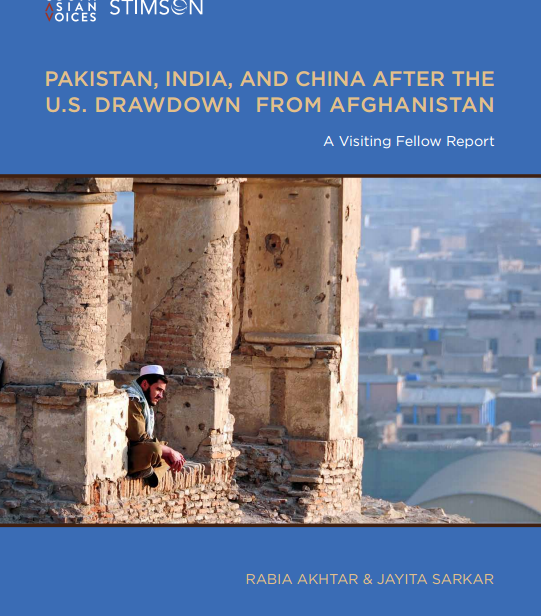
South Asian Voices, a project of the Stimson Center, is a website featuring commentary and debate from a generation of rising strategic analysts in India and Pakistan. Articles cover a variety of issues, including Indian and Pakistani external relations, India-Pakistan nuclear dynamics, nuclear security, energy issues, political events, and non-traditional security concerns. Stimson selects from among the authors four visiting fellows every year for a one-month visiting fellowship in Washington.
Rabia Akhtar and Jayita Sarkar were part of the first cohort of South Asian Voices Visiting Fellows at the Stimson Center in July 2014. “Pakistan, India, and China after the U.S. Drawdown from Afghanistan: A Visiting Fellow Report” is the product of this fellowship.
Excerpts from this report:
“As American involvement in South Asia enters a new phase after Washington’s impending military withdrawal from Afghanistan, much uncertainty prevails with respect to the most appropriate strategy for maintaining stability in the region. Domestic political instability in Pakistan—an important American ally—continues, cross border tensions rage between India and Pakistan, and terrorism continues to threaten civilian life in Pakistan, India, and in the Xinjiang province of China. All this further enhances concerns about the nature and character of the regional strategic environment in the coming years. This paper examines the strategic future of South Asia in the wake of the U.S. drawdown from Afghanistan through three key research questions: first, how does the U.S. drawdown from Afghanistan affect the regional security and economic interests of India, Pakistan, and China? Secondly, what kinds of responses to terror attacks by India, Pakistan and China could further destabilize the region? Thirdly, what key steps can the United States take to prevent further instability in this context? “
The paper introduces the U.S. drawdown strategy from Afghanistan and addresses how the U.S. drawdown will affect the security and economic interests of Pakistan, India, and China. It also examines possible crisis scenarios involving Pakistan, India, and China in Afghanistan and their impact on regional stability. Finally, it underlines future projections and policy recommendations. They conclude that:
“While the lure of path dependency can be high in military problem-solving, it can also be dangerous in an ever-dynamic conflict situation. Throughout history, large powers like the United Kingdom and the Soviet Union have burnt their fingers in their attempt to control the stretch of land that is modern-day Afghanistan. The international community’s attempt, led by the United States, to defeat the Taliban and create a stable democracy in Afghanistan has not been entirely successful. What is needed in Afghanistan is the prevention of its possibly imminent implosion. Given the nature of the current situation, it seems that matters will not improve drastically if Afghanistan is left to itself. There are too many rival power centers within the country and in the region at large. The current nature of this conflict is such that any power vacuum would quickly be filled by an array of non-state actors subscribing to varying degrees of violent Islamist fundamentalism. Moreover, as of December 2014, South Asia seems to be becoming one of the most dangerous places on earth, where the challenge of terrorism and the continuous threat of a nuclear exchange loom large. As a result, it would be in Washington’s interest to initiate systems to engage regional stakeholders, namely, India, Pakistan, and China, through mechanisms like counter-terror cooperation, such that a spillover from the conflict in Afghanistan does not destabilize the region any more than it already has.”